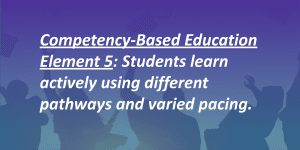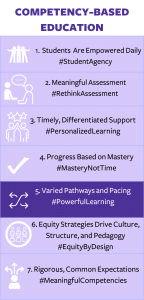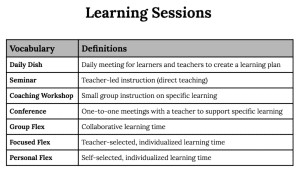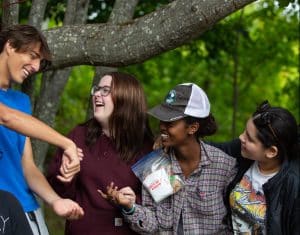CBE Starter Pack 5: Learn Actively With Varied Pathways and Pacing
CompetencyWorks Blog
When educators begin to explore competency-based education (CBE), the CompetencyWorks Initiative is a key place to start, but it can be overwhelming to take it all in. This post is the fifth of a series of “CBE Starter Packs” focused on each of the seven elements of the Aurora Institute’s 2019 CBE Definition.
 The fifth element was added in the 2019 update of the CBE definition to emphasize that learning in a CBE system is not “sit and get” and it is not one-size-fits-all. The prior elements of the CBE definition – learner agency (element 1), assessment for learning systems (element 2), support structures (element 3), and students progressing based on evidence of mastery (element 4) – culminate in element 5 with active learning using different pathways and varied pacing. The learning sciences emphasize that learning is something done by students, not to or for students. In CBE, students learn how to learn, which requires active engagement.
The fifth element was added in the 2019 update of the CBE definition to emphasize that learning in a CBE system is not “sit and get” and it is not one-size-fits-all. The prior elements of the CBE definition – learner agency (element 1), assessment for learning systems (element 2), support structures (element 3), and students progressing based on evidence of mastery (element 4) – culminate in element 5 with active learning using different pathways and varied pacing. The learning sciences emphasize that learning is something done by students, not to or for students. In CBE, students learn how to learn, which requires active engagement.
Active, Personalized Learning
Personalized learning – tailoring learning to each student’s strengths, needs, and interests in a way that enables student voice and choice in what, how, when, and where they learn – provides a foundation for active learning. Incorporating Universal Design for Learning (UDL) and culturally responsive strategies support equitable access to active and personalized learning.
- Universal Design for Learning (UDL) is a framework to improve and optimize teaching and learning for all people based on scientific insights into how humans learn. It incorporates multiple ways to personalize engagement, representation, and action/expression.
- Culturally responsive strategies focus on identity development, relationship-building, and learning experiences that respect each student’s personal and cultural identities. These strategies resonate and align with CBE (Learn more through this bibliography of Culturally Responsive Pedagogy).
At the same time, there is no checklist or one right way to approach pedagogy in CBE. Much like CBE offers choice for learners, it offers choice for schools. Example school-level pathways with a CBE-aligned approach include instructional models, such as Project-Based Learning (PBL), and school models, such as EL Education and Big Picture Learning.
The Role of Pathways and Varied Pacing
 The Frequently Asked Questions section of the updated CBE Definition describes the intentions behind different pathways and varied pacing, which are slightly adapted here.
The Frequently Asked Questions section of the updated CBE Definition describes the intentions behind different pathways and varied pacing, which are slightly adapted here.
What do we mean by “different pathways”?
In competency-based schools, student pathways are personalized, reflecting each student’s unique needs, strengths, interests, goals, and pace. The order in which students master learning targets both within and across academic disciplines may vary. Rather than coupling the standards with specific ages or grade levels, they are based on learning progressions that provide guidance to students within their zone of proximal development. Personalized learning experiences may include formal and informal learning opportunities both within and outside schools. Varied pathways (and pacing) should not be mistaken for the inequitable, traditional practice of tracking. CBE meets students where they are to ensure that each student can attain the same high standards.
What do we mean by “varied pacing”?
In competency-based schools, pacing is no longer uniform. The primary goal is deeper learning, not faster learning. Varied pacing can mean that students who are proficient in certain standards are encouraged to engage in ways that lead to greater depth of knowledge and multiple ways of demonstrating competency. Varied pacing does not imply that there is a single learning pathway that students simply navigate at different speeds. To ensure that CBE fulfills its function as an equity strategy, attention to each student’s pace of progress matters. To avoid unintentionally exacerbating inequities, schools actively monitor progress and provide more instruction and support if students are not on a trajectory to graduate by age 18 or soon after.
What does active learning with varied pathways and pacing look like?
These examples illustrate how real schools design active, competency-based learning experiences in ways that fit their own local communities.
An Example Grounded in Real World Learning: Iowa BIG 
Iowa BIG, “Iowa’s initiative-based, entrepreneurial high school experience,” is a partial day program where students can attend up to three classes each day. Learning happens through real-world projects. Iowa BIG pushes the limits of what many people think of as “school.” It is co-located in a business incubator and coworking space, with the students using the same rooms as the start-up businesses. The following principles inform the learning design:
- Focus on kids’ passions: because most successful adults have passion for what they’re doing;
- Get kids out doing real work: the community has more problems and opportunities than the adults can address on their own. The Cedar Rapids area has 7000 high school students—an untapped resource for the community;
- Make sure kids are learning content in an integrated way: academic rigor is essential, but it must be relevant.
Depending on the projects and roles students take on, they develop and demonstrate learning targets on unique pathways with varied pacing.
Learn More About Iowa BIG: Going BIG in Cedar Rapids, Iowa BIG Animation Overview Video, The Iowa BIG podcast
More Examples Grounded in Real-World Learning:
- In Kettle Moraine School District in Wisconsin, KM Global is one of several small, personalized high schools that creates opportunities to broaden students’ horizons and explore high-interest questions about the world. KM Global provides choice to students about how they learn and demonstrate their learning.
- Four Rivers, an EL Education school in Massachusetts, provides an example of Active Learning through Expeditions and Internships.
- Read about the real-world learning from one student’s experience in a Big Picture Learning setting in Supporting Deeper Learning Through High-Quality Internship Projects.
An Example Grounded in Flexible, Interdisciplinary Scheduling: Boeckman Middle School in Farmington, Minnesota
 Boeckman Middle School, in the Farmington Area Public Schools, Minnesota, brings a competency-based approach to selected subjects and grade levels during Interstellar Time. Interstellar Time is a four-and-a-half-hour block of time every other day where learners receive personalized, interdisciplinary instruction. Each day of Interstellar Time begins with students scheduling their time for the day, based on their personal learning needs and progress. Every student has a device and teachers build playlists of learning activities and assessments aligned to competencies that students need to demonstrate. The Interstellar learning spaces also vary to facilitate different types of activities. Key elements of CBE, such as varied pacing, targeted support for all students, and performance-based assessments can be implemented more effectively with flexible scheduling.
Boeckman Middle School, in the Farmington Area Public Schools, Minnesota, brings a competency-based approach to selected subjects and grade levels during Interstellar Time. Interstellar Time is a four-and-a-half-hour block of time every other day where learners receive personalized, interdisciplinary instruction. Each day of Interstellar Time begins with students scheduling their time for the day, based on their personal learning needs and progress. Every student has a device and teachers build playlists of learning activities and assessments aligned to competencies that students need to demonstrate. The Interstellar learning spaces also vary to facilitate different types of activities. Key elements of CBE, such as varied pacing, targeted support for all students, and performance-based assessments can be implemented more effectively with flexible scheduling.
Learn More About Boeckman MS: Interstellar Time at Boeckman Middle School
More Examples Grounded in Flexible and Creative Schedules:
- Littles, Middles, Molders, and Olders – Multi-age Learning at Journey Elementary in Harrisburg, South Dakota offers an elementary model with multi-age groupings and flexible schedules.
- Strategies for Responsive Pacing at the Success Center in Holyoke, MA offers a model for responsive pacing built on student agency, innovative course structures and scheduling, and a variety of student supports.
- Legacy High School in Bismarck, North Dakota uses Flex-Mod Scheduling to Enable Competency-Based Learning. Flex-Mod scheduling breaks the day down into 20-minute modules which can be combined flexibly to personalize learning on a daily basis.
What do we look for in the student experience?
 Can you see these student experience “look fors” in the examples above?
Can you see these student experience “look fors” in the examples above?
- Students understand their own learning path and how to advance. They can make daily choices about how they learn.
- Every student has the opportunity to actively apply their knowledge and skills as they engage in deeper learning through robust inquiry or projects.
- Student learning is monitored along a developmental competency continuum rather than completion of grade-level standards within a year or course.
- Students develop, practice, and apply the mindsets, motivations, and skills they need to develop agency to navigate their learning and engage actively.
What school policies and practices support active learning with varied pathways and pacing?
- Learning experiences and instructional strategies meet the needs of diverse learners. Learner-centered and culturally responsive practices include, but are not limited to, communication of high expectations, active-learning teaching methods, student-driven discourse, and flexible grouping.
- All students have multiple opportunities to apply learning and build higher-order skills. Performance-based assessment and real-world learning beyond the classroom through experiential and work-based learning support these opportunities.
- Pathways of learning develop critical competencies that support learners’ personal, professional, and academic development through the exploration of different career or interdisciplinary focus areas.
- School-wide approaches help students develop the building blocks of learning and self-direction, such as growth mindset, metacognition, and self-regulation.
- Time is flexible with opportunities during the school day to receive additional instructional support to ensure students can master content and skills without having to repeat courses or grades.

Learn More
There are many blog posts, Aurora Institute Symposium sessions, webinars, toolkits, and organizations contributing to our knowledge and practice of effective personalized instruction for active learning with varied pathways and paces. Here are a few to get you started.
- What’s Possible with Personalized Learning? An Overview of Personalized Learning for Schools, Families & Communities illustrates what personalized learning looks like in practice. Find examples of teachers personalizing learning and student perspectives on how new instructional designs meet their unique needs.
- Getting Smart’s New Pathways Campaign offers an evolving roadmap and set of resources to support the goal that every learner, regardless of zip code, is on a pathway to productive citizenship, high-wage employment and economic mobility, and a purpose-driven life.
- A longitudinal study of Big Picture Learning graduates found that the model, which includes active, personalized learning through internships, successfully meets its goals of fostering positive relationships, helping students discover and pursue their interests, and promoting high school graduation and college entrance.
- A Promise for Equitable Futures: Enabling Systems Change to Scale Educational and Economic Mobility Pathways outlines a call to action for states to enact a Learner Promise: a commitment that every learner will have access and support to pursue a certified pathway with system-wide opportunities to thrive in their careers and lives.
- Multiple Aurora Symposium sessions share examples in practice. In Creating Equitable, Community-Based, Learner-Centered Ecosystems, hear from students, youth development providers, and learner-centered leaders about real-world learning beyond the classroom in Rhode Island. Falcon Middle School students in District 49 in Colorado describe their personalized learning journey in the session, How Our Voices and Choices Are Leading to Student Ownership.
- The CBE Design Principle 5 Rubric is a resource from the book, Unpacking the Competency-Based Classroom, in which Vander Els and Stack offer a roadmap for transforming schools in pursuit of greater equity through competency-based learning. It has indicators for Learning Outcome and Disposition Design, Instructional Strategies, and Expanded Learning Opportunities.
Supporting Design and Equity Principles
The information above is synthesized from key Aurora and CompetencyWorks publications. In particular, Designing for Equity: Leveraging Competency-Based Education to Ensure All Students Succeed and Quality Principles for Competency-Based Education.
Key Principles for Learning with Varied Pathways and Pacing:
- Equity Principle (p. 23): Monitor and Respond to Student Progress, Proficiency, and Pace
- Equity Principle (p. 15): Nurture Strong Culture of Learning and Inclusivity
- Quality Principle #6 (p. 54): Base School Design and Pedagogy on Learning Sciences
- Quality Principle #14 (p. 92): Increase Organizational Flexibility
Get Started
Reflecting on your own or with your team, school, district, and/or community can help to identify assets to build on in designing active learning with varied pathways and pacing.
- What systems, practices, and routines are in place so that students understand their own learning path and how to advance?
- In what ways are educators supported in differentiating and personalizing learning in order for students to reach common, rigorous educational outcomes and discover talents and interests along varied pathways?
- What strategies are in place to support students in building the capacities that enable active learning, such as metacognitive and social and emotional skills?

Good luck! For additional resources, try browsing on the CompetencyWorks Blog with its many stories by innovators and early adopters from across the field of K-12 CBE.
Other Posts in the Starter Pack Series
- CBE Starter Pack 1: Students are Empowered Daily
- CBE Starter Pack 2: Meaningful Assessment
- CBE Starter Pack 3: Timely, Differentiated Support
- CBE Starter Pack 4: Progress Based on Mastery
- CBE Starter Pack 6: Equity Strategies Drive Culture, Structures, and Pedagogy
- CBE Starter Pack 7: Establish Rigorous, Common Expectations with Meaningful Competencies
Stay tuned for future posts!
Laurie Gagnon is the Aurora Institute’s CompetencyWorks Program Director.